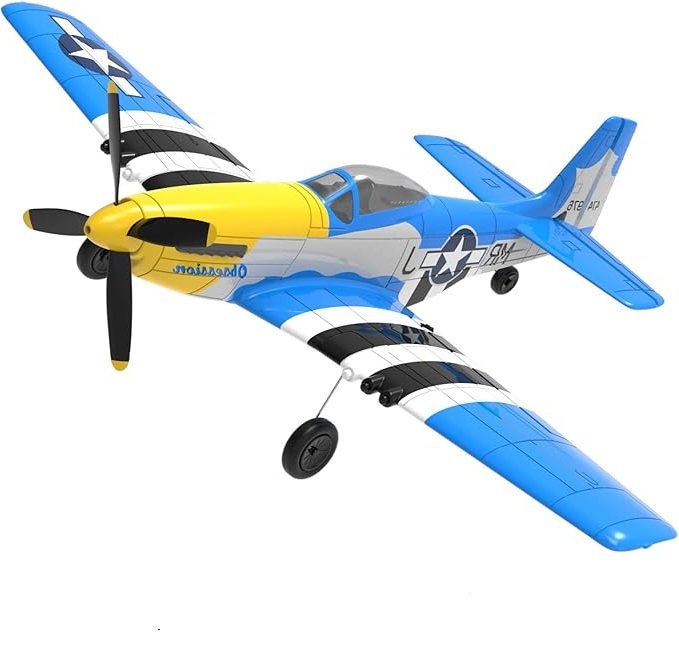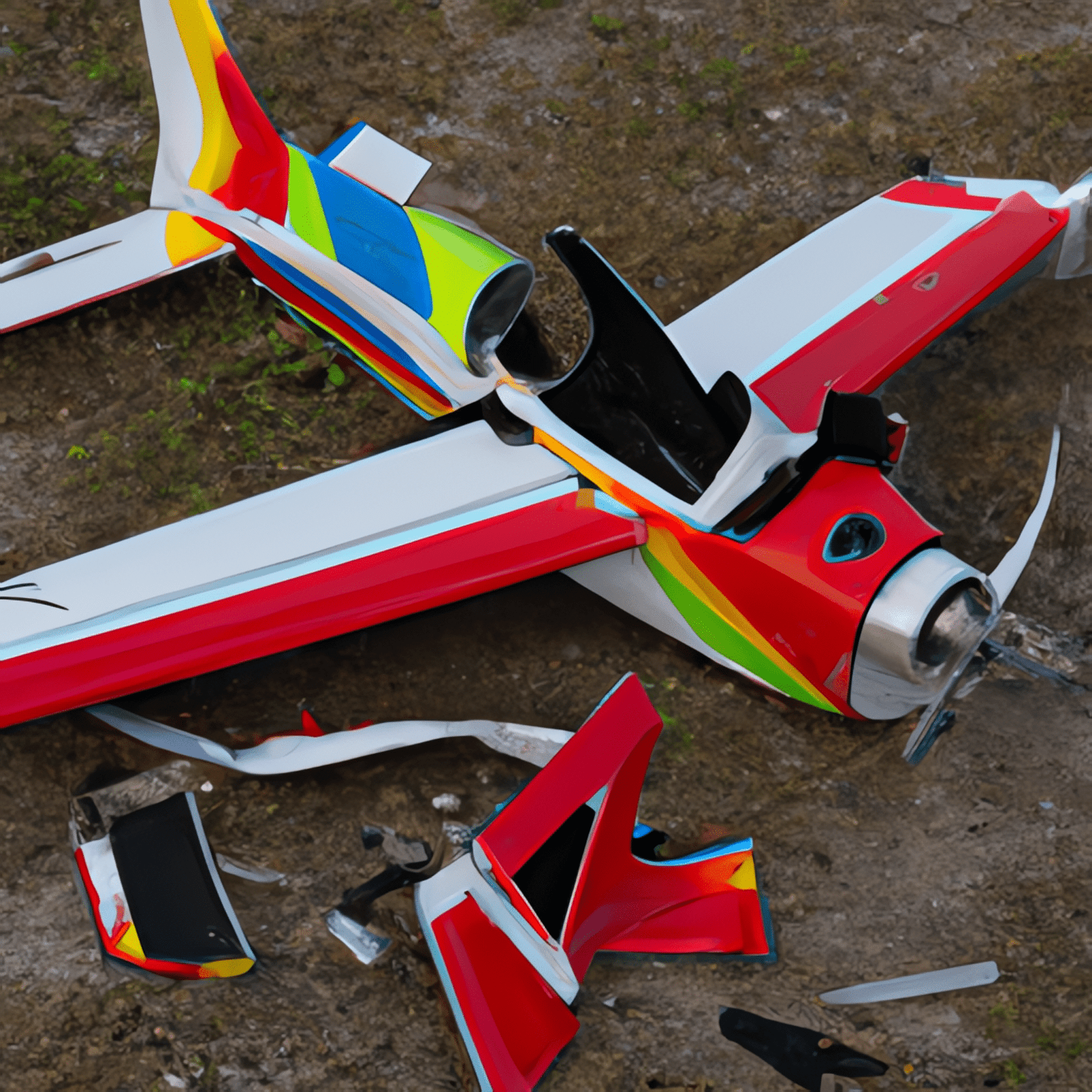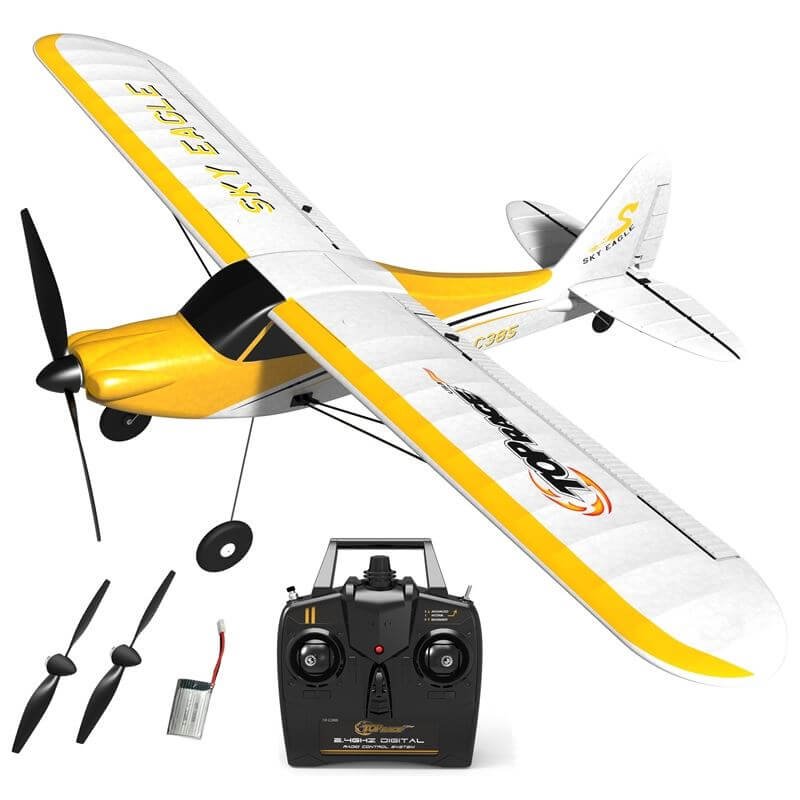There’s nothing like waiting all week for the chance to spend the weekend flying your RC plane, only to see the rain start to fall. It’s sooo tempting to press on and fly anyway – but can RC Planes fly in the rain? This article looks at the risks of flying in wet weather and the steps you can take to reduce these.
Yes, RC planes can fly in light rain but it is inadvisable to fly in anything heavier. There are risks of water penetrating the electronics, receiver, servos and/or batteries, whether it’s an electric or internal combustion engine. Water could also damage the transmitter. Heavy rain could also make controlling the plane difficult.
Just starting out with RC Planes? Take a look at the latest recommended RTF (ready to fly) and easy-to-fly RC Planes, which will make getting into the air easy peasy and cheap – here.
- Things to Consider When Flying RC Planes in Rain
- Can You Actually Fly In The Rain?
- What Measures Can I Use To Protect the Electrical Components in an RC Plane from Moisture?
- Does Rain Impact Radio Frequency?
- Rain May Affect The Weight of the Plane
- Rainy Conditions Can Impact Visibility
- Pooling Water on the Ground Could be a Hazard
- Can You Land Your RC Plane on Water?
So what are the main considerations when flying an RC plane in the rain? I looked at these from a novice’s point of view:
Things to Consider When Flying RC Planes in Rain
What the Experts Say
I always defer to my guides and mentors when researching a topic I haven’t had agreat deal of experience with (as I tend to avoid flying in the rain, because I don’t like getting wet!)
Unfortunately it seems most of the experts are pretty silent on the matter, leaving it at “best to avoid flying in the rain”, but that doesn’t help the many of us who may be caught out by a heavy rain shower, or who live in areas of the world which are prone to damp conditions.
The august body the Academy of Model Aeronautics has nothing to say on the matter, and it’s a case of sifting through forum sites such as RC Universe to get a few answers.
Here, though, are the things you need to know:
Electrical Components
If you are a novice like me, it may be helpful to detail the main components of an RC plane which are at risk from water penetration:
- Transmitter – The transmitter is the handheld control box which transmits the radio signal to the model.
- Receiver – The receiver is the equipment in the model which receives the radio signal from the transmitter and interprets the control instructions for each servo.
- Servos – These are small black boxes which, via a metal rod or linkage, control the moveable surfaces of the model plane, such as the elevators (making the plane go up or down) and the ailerons (which make the plane bank left or right), or control the plane’s throttle.
- Electronic speed controller – this is a small black box which is used to control engine speed in electrically powered models.
- Battery Packs – usually ni-cad rechargeable batteries are included in the model to power the moter and servers.
- Autopilot – many modern planes now have an autopilot which automatically returns the the control surfaces to neutral if there is a loss of control.
As you will see, there are many electrical components that make up a modern RC plane. Any water ingress into any of these might, at best, affect the model’s performance, and at worst cause the operator to lose control and crash.
The main consideration is water may cause an internal electrical short, thereby damaging the part and causing it to stop operating as it should.
Rust
Additionally, apart from the short term effects of rain water penetrating electrical components, there is always the long term consideration of rust, which may form on exposed metal parts of the airframe, the propeller shaft, and components such as connector rods and terminals.
Can You Actually Fly In The Rain?
There’s no doubt that flying in heavy rain could destabilise the plane and make it difficult to control. Heavier rain drops could knock a lighter, foam constructed rc plane out of the sky.
However, whilst it’s wise to avoid flying in the rain whenever possible, you shouldn’t get too hung up on your plane receiving a dousing – I’ve seen a number of instances of planes being successfully flown in very wet conditions. In these cases there was no long term harm done to the plane and its components, it remained under control, and a thorough drying out using an absorbent cloth and even a hair dryer prepared the model for its next flight.
To illustrate this, here’s a video of such a flight. The operator seems surprised his plane wasn’t affected by the heavy rain it encountered:
What Measures Can I Use To Protect the Electrical Components in an RC Plane from Moisture?
There are a number of measures you can take to make the electrical components better protected from water:
The Hand held transmitter – either shelter under a convenient open canopy – eg your car’s rear door – or put the transmitter in a bag. You really don’t need anything fancy or expensive to keep the transmitter waterproof.
The simplest, and cheapest, thing to do is keep the transmitter inside a plastic bag from the grocery store with a hole cut for the antenna would suffice in an emergency.
Or you could use a proprietary bag – this would have the added advantage of keeping your hands warm in cold weather.
On board electrical components – these are more difficult to protect from moisture.
Firstly ensure that all the parts of the model’s fuselage fit together well, with no or little gaps where water can get in. For example the electrics will no doubt be accessible via removable hatches in the fuselage or canopy – make sure these fit well, and if not try fitting some foam around the inside lip of the opening to absorb any moisture which comes in.
For any non-opening joints in the plane’s structure – such as where the wings join the fuselage – you could consider applying tape, pva or silicon glue or Plastidip, an air-dry, specialty rubber coating.
Applying a Plastidip Coating
If you want to waterproof the ouside of your RC plane and not spend a fortune, you can use Plastidip. The amount you get in a can is more than enough for a large RC plane. The product is available at most hardware stores, or can be bought online here (Amazon link).
Firstly remove or tape off ALL electronic components from your plane, to avoid pouring the product into them.
Using a spray can of Plastidip, apply the spray at about six to eight inches away – never go too close or you may warp the outer covering of the plane.
If you need to apply more than one coat, carefully clean the spray nozzle. I’ve noticed that if there’s residue on the nozzle, the spray will leave bumps on your plane, making it look and feel uneven to the touch.
After you’ve applied the first coat, leave the plane for around five to ten minutes to dry out. Make sure you’re in a properly ventilated area and never try to cover the whole plane in this first coat.
Add another layer of the coat to the places you’ve missed.
When all the coats have been applied, leave the plane for one hour at least, before you start flying it. The finished surface should be smooth and shouldn’t leave Plastidip on your fingers after you touch it.
An alternative to Plastidip is Rain-X (Amazon link), a synthetic hydrophobic surface-applied product that causes water to bead.
Some models will be designed with the components exposed. In these cases there is probably little you are going to be able to do to protest these. Most rc planes will, at the very least, have the front of the engine exposed behind the propeller.
Protecting the Electrical Components Directly from Rain
The electrical components themselves can be sprayed with a proprietary lubricant / penetrant, such as Corrosion-X (Amazon link). This will have the double effect of protection from some moisture exposure and a long term lubricant and protection from corrosion.
However, don’t rely on this to completely waterproof the electrics – it will only give short term protection from rain ingress. A sort of shower proofing, as opposed to a waterproofing!
A more permanent solution is to cover the non – moving components in silicon glue (Amazon link), which is relatively cheap. It’s the sort of material that fishkeepers use to seal their tanks, so it must be good!
Here’s a short video I found of this material in action on an RC plane which wasn’t designed to go in water, but whose owner liked to use it from the back of his jetski!
Does Rain Impact Radio Frequency?
Heavy rain has been said to impact planes that fly on higher frequencies, like the 2.4Ghz range. This could result in loss of control of your plane as the transmission is interrupted.
However, many hobbyists report that in light to moderate rain, this is not an issue, but it’s certainly something to keep in mind when planning to launch in rain.
Rain May Affect The Weight of the Plane
If the rain gets into the shell of the model, it may pool and create additional weight. This may result in the aircraft struggling to climb or maintain its height.
Rainy Conditions Can Impact Visibility
Many people may not realize how disorienting an overcast sky can be for a flier, especially if you are used to flying in clear conditions. The poor weather can make it really tough to judge distances, so be extra cautious when flying on an overcast day, even if rain is not a factor.
The other issue is keeping an eye on your plane in the rain. Your eyewear may fog up, it could be difficult to see your transmitter, combined with an overcast sky may make it tougher to keep a close eye on your plane. It may even disappear into the cloud.
Pooling Water on the Ground Could be a Hazard
After a good downpour puddles may form and make landing the plane tricky. I have seen instances where a plane has safely touched down only to end up cartwheeling as its wheels struck a deep puddle or patch of mud.
Other Related Questions
Can You Land Your RC Plane on Water?
Yes, you can land your RC Plane on water, providing it is suitably waterproofed, inside and out. Ideally it should be designed as a seaplane, with boat shaped hull and floats, but it is possible to sufficiently waterproof a normal RC Plane to survive infrequent landings in water.




